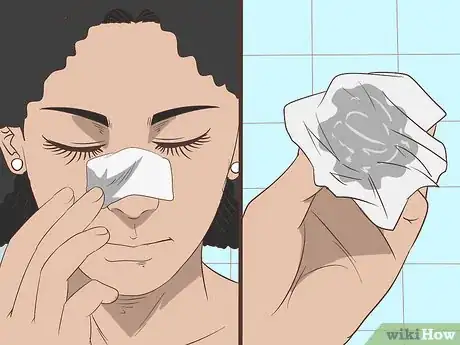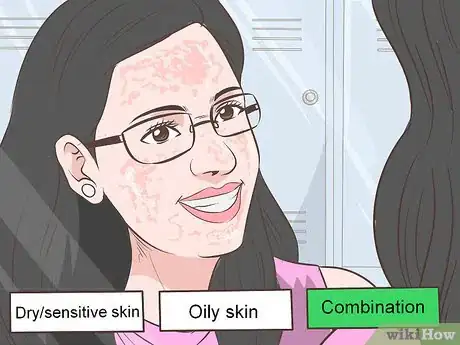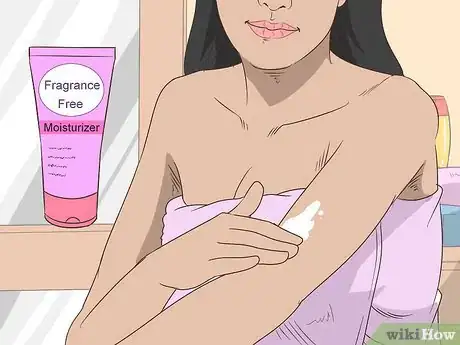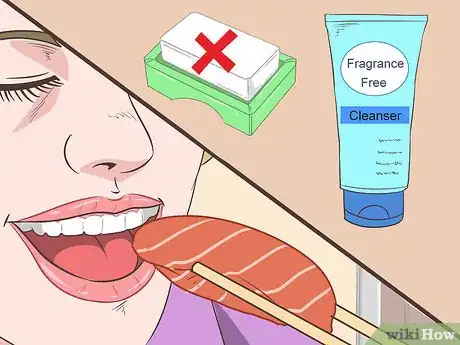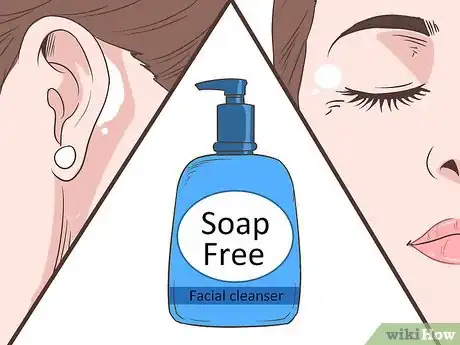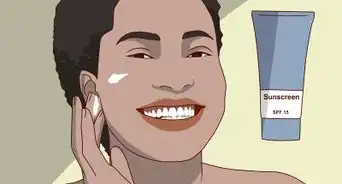This article was co-authored by Mohiba Tareen, MD. Mohiba Tareen is a board certified Dermatologist and the founder of Tareen Dermatology located in Roseville, Maplewood and Faribault, Minnesota. Dr. Tareen completed medical school at the University of Michigan in Ann Arbor, where she was inducted into the prestigious Alpha Omega Alpha honor society. While a dermatology resident at Columbia University in New York City, she won the Conrad Stritzler award of the New York Dermatologic Society and was published in The New England Journal of Medicine. Dr. Tareen then completed a procedural fellowship which focused on dermatologic surgery, laser, and cosmetic dermatology.
There are 9 references cited in this article, which can be found at the bottom of the page.
wikiHow marks an article as reader-approved once it receives enough positive feedback. In this case, 83% of readers who voted found the article helpful, earning it our reader-approved status.
This article has been viewed 1,156,039 times.
It's essential to know your skin type if you want healthy and flawless skin. Knowing your skin type allows you to select the right products and customize a skin care regimen that will work best for you. The main skin types to consider include: dry, oily, combination, normal, acne-prone, and sensitive. You might be wondering how in the world you’ll ever differentiate between all these skin types! But don’t worry. There are simple ways to determine your skin type.
Things You Should Know
- Dry or sensitive skin feels tight after washing, looks red, or wrinkles when pinched. Oily or combination skin is shinier, has big pores, or feels smooth.
- When in doubt, ask your dermatologist what kind of skin you have and what regimen will work best for you.
- Regardless of the skincare routine you choose, drink lots of water to stay hydrated and support a healthy complexion.
Steps
Examining Your Skin
-
1Dab your face with a tissue. Wait an hour after washing your face and then pat your T-zone with a tissue. Look at the tissue to determine if oil rubbed off on it. If it did, you either have oily or combination skin.[1]
- Your T-Zone includes your forehead and nose. The region is called the T-zone because the bridge of your nose forms the base of the “T”. The part of your forehead above your eyebrows forms the top of the “T”.
-
2Notice how your skin feels. If you have dry skin, your face will feel tight after cleansing whereas oily skin will feel cleaner right after washing it. Your T-zone will feel clean if you have combination skin, but your cheeks will feel tight. Sensitive skin will react to certain cleansers, and may cause itchy skin or a rash.[2]
- If you have sensitive skin, your face will get red, itchy, or a rash could form after using certain facial products.
- Oily skin will start to feel greasy again as your day continues.
- If you're noticing your skin doesn't fall under any of these categories and you're free of problem areas, you have normal skin which requires low maintenance! Congratulations!
- You can get pimples or acne at any age, especially if you have an oily skin type.
Advertisement -
3Look in the mirror. If you notice red, flaky patches all over your face, you most likely have dry and/or sensitive skin. If your face is shiny all over, you have oily skin. A combination of both means you have combination skin.[3]
-
4Look at your pore size. If you have normal skin, your pores will be visible but not large. Take a few steps back from the mirror. If you still see your pores, you have oily skin. If your pores are not at all visible, you have dry skin.[4]
- Combination skin occurs when you have more than one pore size on your face resulting in a combination of dry, oily and normal skin.[5]
-
5Pinch your skin. If your skin easily wrinkles after pressure is applied, you have dry or combination skin. Oily skin will feel smooth.
-
6Ask your dermatologist. If you're still at a loss for determining what type of skin you have, your dermatologist can provide you with answers to your skin questions. There are some over the counter medications they can prescribe and procedures they can perform to treat your dry, oily, sensitive, combination or acne-prone skin if all else fails.
Treating Your Skin
-
1Apply moisturizer to dry skin. Apply a fragrance-free cream to the dry areas on your skin. Don't overdo it on the soap when you take a shower, and use warm water, not hot water.[6]
- Only use soap on the dirty parts of your body, like your armpits, your groin, under your breasts, and between your toes. Using soap all over can dry out and irritate your skin.[7]
- Dry skin can also lead to dermatitis. In this case, treat your problem areas with hydrocortisone ointment.
-
2Cleanse morning and night if you have oily skin. Apply a gentle facial cleanser with warm water to wash your face for 30 seconds to a minute. Treat your problem areas with facial products containing benzoyl peroxide, alpha hydroxy acid, and retinoids.[8] . You can also use products with glycolic acid or salicylic acid. Buy a small sample before trying these spot treatments or medicated pads so you can test which one works the best on your face.[9]
- You can also use blotting paper to remove excess oil from your face. Press it against the oily area for about 15 seconds. This will absorb the oil and make your face appear less shiny.
- Don't avoid moisturizer. Even oily skin needs to be moisturized, just use an oil-free moisturizer.
- Avoid using too many products at once to tackle oily skin. Drying out your skin too much can actually cause your skin to produce more oil to compensate.[10]
-
3Find a balanced treatment for combination skin. Use a fragrance-free gentle cleanser to wash your face, and avoid soaps with harsh chemicals. Eat more foods with essential fatty acids including salmon, flaxseed and walnuts or take a fish oil supplement. This will help moisturize your skin without adding oil to it.[11]
-
4Use a soap-free facial cleanser on sensitive or acne-prone skin. Use a gentle facial cleanser without added fragrance or chemicals in order to prevent skin irritation. Moisturize your skin to prevent potential breaking of dry spots. Test skin products before using them by applying a small amount behind your ear, then to the side of your eye, and seeing how it responds overnight.[12]
-
5Stay hydrated. Drink water if you want a healthy complexion. Your skin will produce more sebum (oil) if it's dehydrated to keep itself lubricated. If you stay hydrated, your skin will thank you.
Expert Q&A
-
QuestionWhat should I do to start caring for my skin as a teenager?
 Mohiba Tareen, MDMohiba Tareen is a board certified Dermatologist and the founder of Tareen Dermatology located in Roseville, Maplewood and Faribault, Minnesota. Dr. Tareen completed medical school at the University of Michigan in Ann Arbor, where she was inducted into the prestigious Alpha Omega Alpha honor society. While a dermatology resident at Columbia University in New York City, she won the Conrad Stritzler award of the New York Dermatologic Society and was published in The New England Journal of Medicine. Dr. Tareen then completed a procedural fellowship which focused on dermatologic surgery, laser, and cosmetic dermatology.
Mohiba Tareen, MDMohiba Tareen is a board certified Dermatologist and the founder of Tareen Dermatology located in Roseville, Maplewood and Faribault, Minnesota. Dr. Tareen completed medical school at the University of Michigan in Ann Arbor, where she was inducted into the prestigious Alpha Omega Alpha honor society. While a dermatology resident at Columbia University in New York City, she won the Conrad Stritzler award of the New York Dermatologic Society and was published in The New England Journal of Medicine. Dr. Tareen then completed a procedural fellowship which focused on dermatologic surgery, laser, and cosmetic dermatology.
FAAD Board Certified Dermatologist Make sure you always wear sunscreen when you go outside since sun damage can lead to premature aging. You should also apply moisturizer every day. Remember to drink plenty of water, get enough sleep every night, and eat a healthy diet since all of these things can impact your skin.
Make sure you always wear sunscreen when you go outside since sun damage can lead to premature aging. You should also apply moisturizer every day. Remember to drink plenty of water, get enough sleep every night, and eat a healthy diet since all of these things can impact your skin. -
QuestionIn the last 5 years (I'm 67 now), I've had problems with little, white pustules. They do not seem to contain pus or liquid but are hard, little, beady things. What could they be?
 Jennifer Boidy, RNJennifer Boidy is a Registered Nurse in Maryland. She received her Associate of Science in Nursing from Carroll Community College in 2012.
Jennifer Boidy, RNJennifer Boidy is a Registered Nurse in Maryland. She received her Associate of Science in Nursing from Carroll Community College in 2012.
Registered Nurse It sounds like you are describing milia, which are small (1-2 mm), white papule. Milia are tiny, harmless cysts. They develop when a protein called keratin gets trapped under the outer layer of the skin. In adults, sun damage can cause milia. If you want them removed, see a dermatologist. Never try to remove them on your own.
It sounds like you are describing milia, which are small (1-2 mm), white papule. Milia are tiny, harmless cysts. They develop when a protein called keratin gets trapped under the outer layer of the skin. In adults, sun damage can cause milia. If you want them removed, see a dermatologist. Never try to remove them on your own. -
QuestionSometimes my t-zone is oily while the rest of my face is dry. In certain weather conditions, my entire faces becomes dry. I only rarely get a few pimples. What skin type do I have?
 Jennifer Boidy, RNJennifer Boidy is a Registered Nurse in Maryland. She received her Associate of Science in Nursing from Carroll Community College in 2012.
Jennifer Boidy, RNJennifer Boidy is a Registered Nurse in Maryland. She received her Associate of Science in Nursing from Carroll Community College in 2012.
Registered Nurse It sounds like you have dry skin in general, and an oily t-zone develops in warmer, more humid weather. It's not uncommon for skin types to change based on weather and climate. Adjust your skincare routine when notice these changes. When you experience an oily t-zone, use a gentle cleanser for normal skin to wash your entire face, then apply products formulated for oily skin on your t-zone, and products for dry skin on dry areas.
It sounds like you have dry skin in general, and an oily t-zone develops in warmer, more humid weather. It's not uncommon for skin types to change based on weather and climate. Adjust your skincare routine when notice these changes. When you experience an oily t-zone, use a gentle cleanser for normal skin to wash your entire face, then apply products formulated for oily skin on your t-zone, and products for dry skin on dry areas.
Warnings
- Never over-wash your face because it will strip your skin of its natural oil, drying it out. Wash no more than 3 times per day, and always apply moisturizer to the areas that need it.⧼thumbs_response⧽
References
- ↑ https://www.annmariegianni.com/how-to-determine-your-skin-type/
- ↑ https://skinvision.com/en/articles/how-to-determine-your-skin-type-in-four-easy-steps
- ↑ https://skinvision.com/en/articles/how-to-determine-your-skin-type-in-four-easy-steps
- ↑ https://www.skinvision.com/articles/how-to-determine-your-skin-type-in-four-easy-steps
- ↑ http://www.byrdie.com/what-is-my-skin-type/slide2
- ↑ http://www.mayoclinic.org/diseases-conditions/dry-skin/diagnosis-treatment/treatment/txc-20248908
- ↑ Mohiba Tareen, MD. FAAD Board Certified Dermatologist. Expert Interview. 26 March 2020.
- ↑ Mohiba Tareen, MD. FAAD Board Certified Dermatologist. Expert Interview. 26 March 2020.
- ↑ http://www.webmd.com/skin-problems-and-treatments/acne/features/oily-skin#1
- ↑ Mohiba Tareen, MD. FAAD Board Certified Dermatologist. Expert Interview. 26 March 2020.
- ↑ https://www.annmariegianni.com/combination-skin-what-it-is-how-to-cope-and-the-best-products-for-you/
- ↑ http://www.webmd.com/beauty/sensitive-skin-20-questions#2
About This Article
To determine your skin type, start by washing your face and then waiting an hour. After it's been an hour, dab your forehead and nose with a tissue and check to see if any oil rubbed off. If it did, it's a sign that you have oily skin. If there isn't any oil but your face feels dry and tight, you may have dry skin. If parts of your face are oily but other parts are dry, you might have combination skin. Finally, if your skin isn't oily or dry, you most likely have normal skin. To learn how to tell if you have sensitive skin, keep reading!
